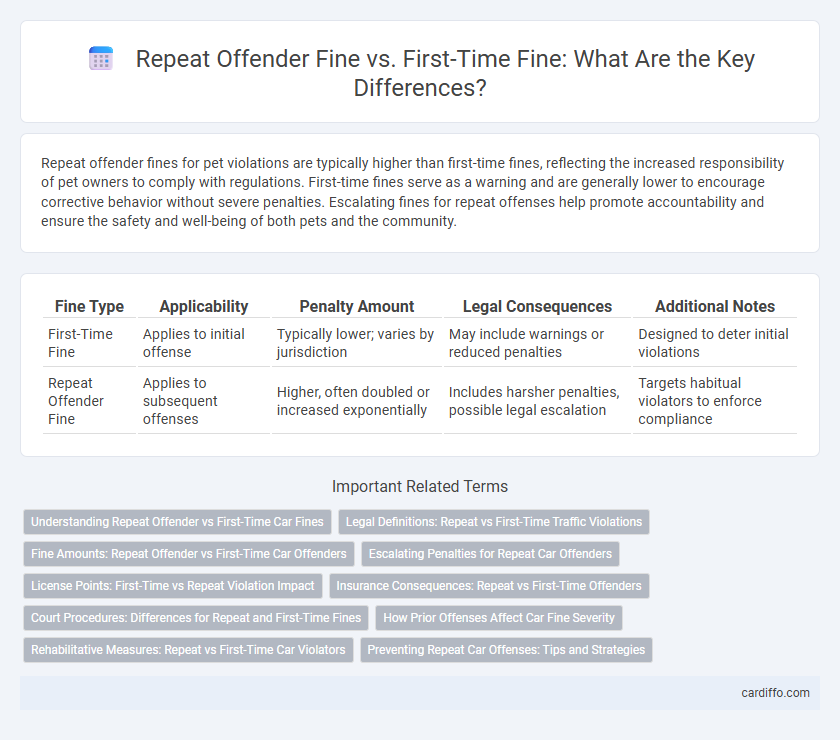Repeat offender fines for pet violations are typically higher than first-time fines, reflecting the increased responsibility of pet owners to comply with regulations. First-time fines serve as a warning and are generally lower to encourage corrective behavior without severe penalties. Escalating fines for repeat offenses help promote accountability and ensure the safety and well-being of both pets and the community.
Table of Comparison
| Fine Type | Applicability | Penalty Amount | Legal Consequences | Additional Notes |
|---|---|---|---|---|
| First-Time Fine | Applies to initial offense | Typically lower; varies by jurisdiction | May include warnings or reduced penalties | Designed to deter initial violations |
| Repeat Offender Fine | Applies to subsequent offenses | Higher, often doubled or increased exponentially | Includes harsher penalties, possible legal escalation | Targets habitual violators to enforce compliance |
Understanding Repeat Offender vs First-Time Car Fines
Repeat offender car fines typically carry higher penalties than first-time fines due to the increased risk posed by habitual violations. First-time fines are generally lower and may include warnings or educational programs, aiming to correct behavior early. Understanding the distinctions between these fines helps drivers anticipate legal consequences and promotes safer driving habits.
Legal Definitions: Repeat vs First-Time Traffic Violations
Legal definitions distinguish repeat offender fines from first-time fines based on prior traffic violation history within a specific time frame, often three to five years. Repeat offenders typically face higher monetary penalties and increased points on their driving records due to the demonstrated pattern of non-compliance with traffic laws. These escalated fines serve to deter habitual violations and promote safer driving behaviors.
Fine Amounts: Repeat Offender vs First-Time Car Offenders
Repeat offenders typically face significantly higher fines than first-time car offenders, with penalties increasing to deter habitual traffic violations. First-time fines usually range from $100 to $250, whereas repeat offender fines can exceed $500, depending on the jurisdiction and severity of the offense. Escalated fines for repeat violations reflect stricter enforcement policies aimed at reducing recidivism and enhancing road safety.
Escalating Penalties for Repeat Car Offenders
Repeat offender fines for car violations significantly exceed those imposed on first-time offenders, reflecting a strict enforcement policy aimed at deterring habitual traffic violations. Escalating penalties often include increased monetary fines, longer license suspensions, and potential vehicle impoundment to address repeat offenses effectively. These measures underscore the legal system's commitment to reducing recidivism and promoting road safety through progressive sanctions.
License Points: First-Time vs Repeat Violation Impact
Repeat offender fines typically carry higher license points compared to first-time violations, significantly increasing the risk of license suspension. Accumulation of points from repeat offenses can lead to escalated penalties, including mandatory driver improvement courses or longer license suspension periods. Understanding the impact of license points is crucial for drivers to avoid compounding fines and maintain driving privileges.
Insurance Consequences: Repeat vs First-Time Offenders
Repeat offender fines often lead to significantly higher insurance premiums compared to first-time fines due to increased risk assessment by insurers. Insurance companies may also impose policy restrictions or even cancellation for repeat offenders, reflecting their higher likelihood of future claims. First-time offenders generally face more moderate premium increases and fewer policy limitations, as insurers view them as lower-risk drivers.
Court Procedures: Differences for Repeat and First-Time Fines
First-time fines often involve streamlined court procedures with options for plea bargains or diversion programs, reducing court time and penalties. Repeat offender fines usually require more rigorous court hearings, increased evidentiary scrutiny, and higher penalties due to prior offenses. Judicial discretion plays a critical role in escalating fines and sentencing severity for repeat violations.
How Prior Offenses Affect Car Fine Severity
Repeat offender fines are significantly higher than first-time fines due to the increased legal consequences tied to prior offenses. Traffic violation databases track an individual's history, which insurance companies and courts use to determine the severity of the fine, often resulting in steeper penalties for repeat offenders. The accumulation of offenses escalates the risk profile, leading to higher financial penalties and potential license suspensions.
Rehabilitative Measures: Repeat vs First-Time Car Violators
Repeat offender fines for car violators typically include higher monetary penalties and mandated rehabilitative measures such as driving courses or community service to address underlying behavioral issues. First-time fines generally emphasize deterrence with lower fees and may offer optional educational programs aimed at promoting safer driving habits. Effective rehabilitation for repeat offenders targets recidivism reduction through tailored interventions, combining financial penalties with corrective actions designed to improve driver responsibility.
Preventing Repeat Car Offenses: Tips and Strategies
Repeat offender fines for car violations are significantly higher than first-time fines, reflecting a legal focus on deterring habitual offenses through escalating penalties. Effective strategies to prevent repeat offenses include enrolling in defensive driving courses, utilizing vehicle tracking technologies, and maintaining comprehensive records of prior infractions to identify patterns. Consistent compliance with traffic laws, combined with proactive behavior modification techniques, reduces the risk of accumulating repeat fines and enhances overall road safety.
Repeat Offender Fine vs First-Time Fine Infographic

 cardiffo.com
cardiffo.com